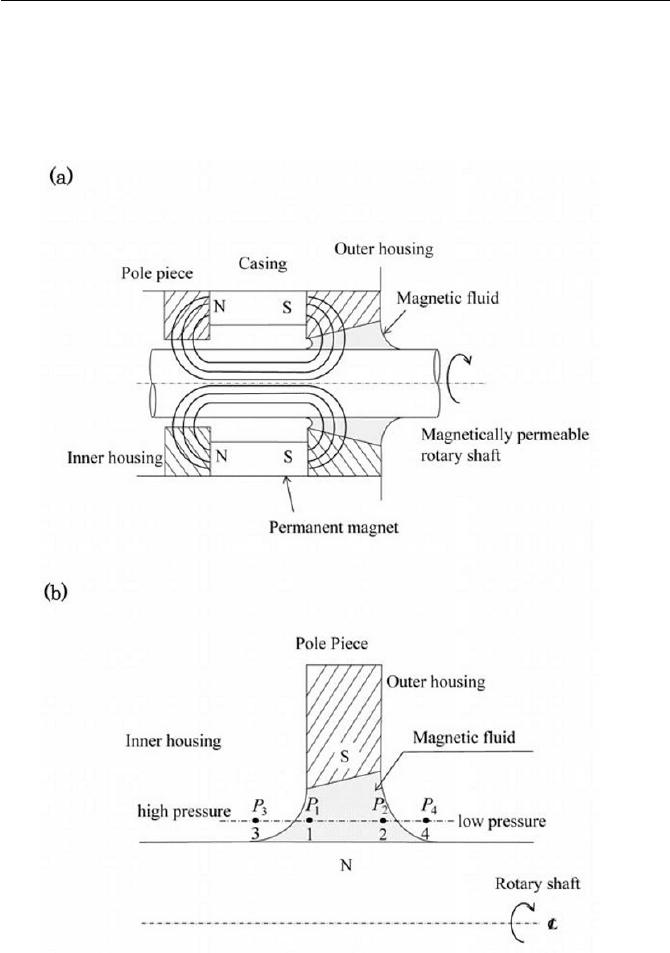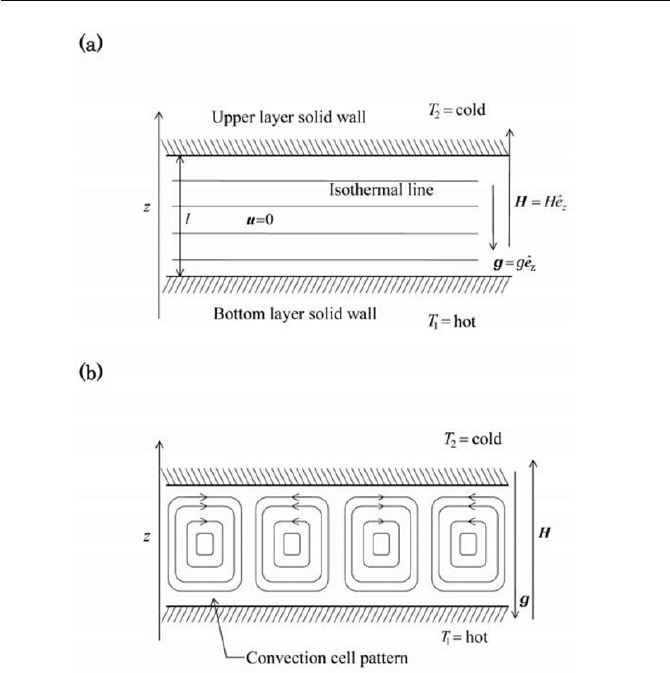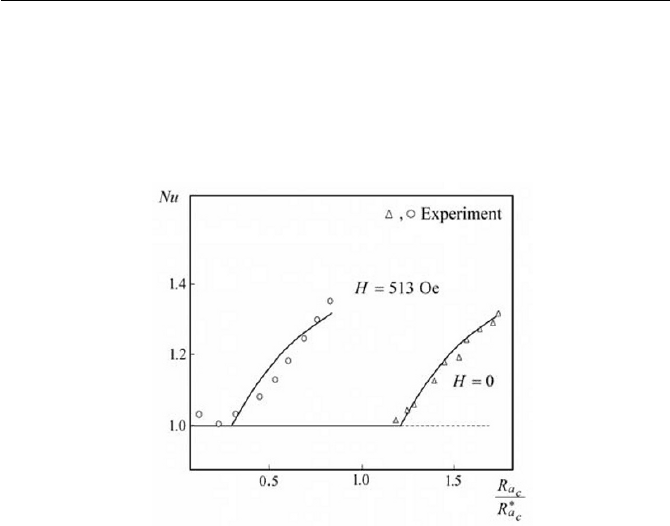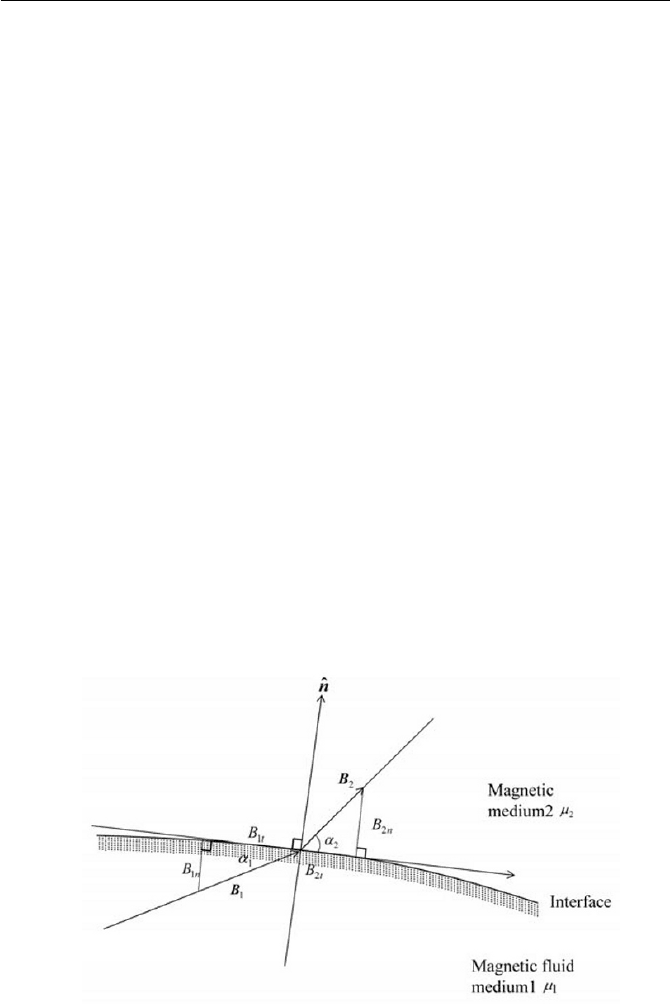Yamaguchi H. Engineering Fluid Mechanics (Fluid Mechanics and Its Applications)
Подождите немного. Документ загружается.


8.3 Basic Flows and Applications
a magnetic body force seems to be one of the most attractive effects in
magnetic fluid statistics. Since the appearance of magnetic fluids, the prin-
cipal application of magnetic fluids is largely found in rotary shaft seals, as
displayed schematically in Fig. 8.8. As seen in Fig. 8.8(a), a small volume
of a magnetic fluid is sustained in the annular region between a rotating
shaft and a surrounding cylindrical magnetic pole, where the magnetic
fluid maintains direct contact with both shaft and pole piece, providing a
virtually leak-proof liquid seal. The pressure difference between the inner
and outer housing, say
3
p (high pressure side ) and
4
p (low pressure side )
with reference to Fig. 8.8(b), can be maintained under a rotating shaft con-
dition. The pressure difference
43
ppp ' , i.e. the seal pressure, can be
estimated by the static equilibrium equation in Eq. (8.3.6), assuming that
the gravitational force is ignored and the magnetic fluid in the gap is in a
static state with a condition of the magnetic field to be tangential at the in-
terface, i.e. 0
n
M . With the magnetic condition at the interface, there
would not be a magnetic pressure jump, so that
31
pp
*
and
42
pp
*
.
Thus, at first approximation, the pressure difference
p can be estimated
by
³
2
1
2143
H
H
dHHMppppp ')'(
**
᧩᧩
(8.3.14)
The integral in Eq. (8.3.14) depends on the magnetization law. In a weak
magnetic field, i.e.
HM
F
, so that the integral is given where
³³
2
1
2
1
2
1
2
2
2
1
H
H
H
H
HHdHHdHHM )(''')'( ᧩
FF
(8.3.15)
In a case of strong magnetic fields,
S
MHM )( , and the integral is of the
form
³
2
1
12
H
H
S
HHMdHHM ᧩''
(8.3.16)
where
S
M
is the equilibrium saturation magnetization given in Eq. (8.1.2).
In a general case, the Langevin formula given in Eq. (8.1.1) can be
used to calculate the integral, which is found to give
^`
2
1
2
1
1
sinhln
H
H
H
H
B
TNkdHHM
³
]]
᧩
')'(
(8.3.17)
The magnetic fluid seals are in commercial use as pressure-, vacuum-
and dust-seals employed in both rotary and reciprocating shafts. As veri-
fied in the text above, the main characteristic ensuring the seal perform-
ance is the magnetic field strength in a gap space. In more technical views,
'
'
525

care must be taken to choose the most appropriate type of magnetic fluid
to prevent deterioration or evaporation of carrier liquids, depending upon
the combination of the contact fluids.
Fig. 8.8 Rotating shaft magnetic fluid seal
8 Magnetic Fluid and Flow
526

8.3 Basic Flows and Applications
8.3.3 Thermoconvective Phenomena
The Kelvin force density
H
M
ේ
that appeared in the Rosensweig equation
is an additional body force term for the gravitational body force (if the
fluid motion under the gravity field is considered). The term
H
M
ේ , as
seen in the previous section, plays an important part in determining the
flow behavior of magnetic fluids. Let us now consider, if a temperature
field
xT
is introduced into the flow field of internal flows, a situation of
a thermomagnetic natural convection that is analogous to a thermal gravi-
tational natural convection.
The problems found in determining the thermomagnetic natural con-
vection are similar to what was considered in the thermal gravitational
natural convection in the way that the onset of a natural convection is
caused by a hydrodynamic instability that breaks the mechanical equilib-
rium of fluid at a hydrodynamically static state, Landau and Lifshitz
(1959) and Gershuni and Zhukhvitskii (1976). In this section, for the sake
of clarity the simplest case of the natural convection, the so-called Benard
convection, is considered as schematically represented in Fig. 8.9. As
shown in Fig. 8.9(a) and (b), the thermal configuration is such that two
dimensional infinite solid horizontal layers are arranged in parallel, in
which the temperature of the interface of the bottom layer is set higher
than that of the upper layer. Between the two layers a magnetic fluid is
charged, where the density
U
and magnetization
0
of the magnetic fluid
posses a spatial non-uniformity due to a temperature distribution. It is as-
sumed that the two solid layers have an infinite magnetic permeability and
a thermal conductivity.
At the beginning, the state of the fluid is at a quiescent state of me-
chanical equilibrium 0
u , where an externally applied magnetic fluid H
and temperature difference
12
TTT
are very small, and the heat is
transferred from the bottom wall to the upper wall by the thermal conduc-
tion through the magnetic fluid layer, as indicated in Fig. 8.9(a). This is the
conduction state, where isothermal temperature distribution persists. As
thermal and/or magnetic conditions are changed, as we will discuss here,
there should be a threshold condition, upon which a natural convection
mode appears, followed with the appearance of cellar structure of flow,
known as the Benard cell as schematically shown in Fig. 8.9(b). With this
mode of flow, i.e. at the state of a natural convection, the heat transfer rate
increases drastically compared to the thermal conduction state due to a
convective motion of flow.
'
527

Fig. 8.9 Problem of Benard convection in thermomagnetic natural con-
vection
In order to develop knowledge in critical phenomena at the occurrence
of a thermomagnetic natural convection, we will examine the mechanism
by firstly writing conditions for a mechanical equilibrium. The requisite
mechanical equilibrium is given by taking the rotation of the Rosensweig
equation at the hydrodynamically static state 0
u , as follows
0
uu HMg
U
(8.3.18)
In examining appropriateness of Eq. (8.3.18), we shall assume here
that the temperature dependence for the properties of
T
UU
and
8 Magnetic Fluid and Flow 528

8.3 Basic Flows and Applications
HTMM ,
, where
T
varies in position
z
likewise
zTT
, so that we
have
T
T
¸
¹
·
¨
©
§
w
w
U
U
and
H
H
M
T
T
M
M
TH
¸
¹
·
¨
©
§
w
w
¸
¹
·
¨
©
§
w
w
(8.3.19)
It is further mentioned that the magnetic fluid is assumed to be homo-
geneous in terms of the concentration of a magnetic phase in a fluid. The
substitution of Eq. (8.3.18) to Eq. (8.3.19) yields the necessary condition
of a mechanical equilibrium, that is
0ේේ u
¿
¾
½
¯
®
¸
¹
·
¨
©
§
w
w
¸
¹
·
¨
©
§
w
w
TH
T
M
T
g
U
(8.3.20)
The existence of the critical phenomena, namely the transition to a
flow of natural convection from the state of thermal conduction requires
the parallelity of
T
to g and
H
. At a condition when this parallelity
is broken, the equilibrium (the static) state would not be possible, at which
moment the onset of a convection motion,
0zu
, appears.
Thermal characteristics found in problems of the Benard convection
are solely determined by the Rayleigh number
Ra as discussed in Exer-
cise 6.2.1, which is defined as
X
EU
c
pT
k
lcT
PrGrRa
4
0
ේg
u
(8.3.21)
The temperature gradient
T is defined by lT ,
p
c is the specific heat,
c
k is the thermal conductivity,
X
is the kinematic viscosity. Note that
T
E
is the coefficient of thermal expansion that is defined as
^`
00
1 TT
T
E
U
U
(8.3.22)
It is further mentioned that
0
U
and
0
T are a reference density and tempera-
ture respectively. All thermophysical values are bulk values of a magnetic
fluid.
Some simplifications are expressed by assuming a linear magnetization
relationship, a so-called soft magnet approximation to the magnetic fluid.
By the use of that from Eq. (8.1.3), the magnetization can be written
analogously to Eq. (8.3.22),
^`
00
1 TTMM
m
E
(8.3.23)
'
529

where
m
E
is defined as the relative pyromagnetic coefficient.
Satisfying the condition of parallelity given in Eq. (8.3.20), i.e.
H//g , with the critical phenomena of the natural convection of a mag-
netic fluid, the Rayleigh number defined in Eq. (8.3.21) can be modified to
write
XEEU
cpmT
a
klc
dz
dT
dz
dH
MR
4
00
))((
*
g
(8.3.24)
The important consequence of deriving the expression found in Eq.
(8.3.24) is that the flow instability at the onset of a natural convection is
adequately described by the known solutions of ordinary thermoconvective
stability problems, by adding an extra term of thermomagnetic force action
to the buoyant force effect.
Taking into account of the magnetic polarization relation expressed in
Eq. (8.2.7), the magnetic field gradient
dzdH can be rewritten by the fol-
lowing sequence
ȂH
0
1
P
(8.3.25)
Equation (8.3.19) has a scalar component for
H
where
MH
0
1
P
¿
¾
½
¯
®
¸
¹
·
¨
©
§
w
w
¸
¹
·
¨
©
§
w
w
H
H
M
T
T
M
TH
0
1
P
(8.3.25)
so that
¿
¾
½
¯
®
dz
dH
dz
dT
M
dz
dH
m
FE
P
0
0
1
(8.3.26)
where the field gradient is given as
¸
¹
·
¨
©
§
¸
¸
¹
·
¨
¨
©
§
dz
dT
M
dz
dH
m
0
0
1
P
F
E
(8.3.27)
Therefore,
*
a
R
in Eq. (8.3.24) can be decomposed into two basic terms as
we
substitute Eq. (8.3.27) for Eq. (8.3.24), yielding
8 Magnetic Fluid and Flow 530

8.3 Basic Flows and Applications
ma
c
p
m
c
p
T
a
RR
k
lc
dz
dTM
k
lc
dz
dT
R
¸
¹
·
¨
©
§
¸
¹
·
¨
©
§
XFP
EP
X
EU
4
2
0
2
2
00
4
0
g
*
(8.3.28)
The first term
aR is an ordinary (thermogravitational Rayleigh number)
and the second term
mR is defined as the magnetic Rayleigh number. An
important result obtained from Eq. (8.3.28) is that the
mR in all directions
of
dzdTT is positive, indicating that in the irrespective of the direc-
tion of the magnetic field gradient
dzdHH the temperature perturba-
tion of the magnetizing field always leads to the thermoconvective fluid
destabilization.
In determining the critical Rayleigh number
c
a
R at the first transition
of the Benard convection, the Rayleigh number at the onset of first appear-
ance of the Benard convection cells, Gotoh and Yamada (1982), show that
(detailed by numerical study) the parameter
F
P
000
HBK , the
characteristic parameter of the nonlinearity of the fluid magnetization
curve, plays an important role, and further show that in cases where
foK
(sufficiently large K ), the stability problem will become a con-
ventional stability problem of a Benard convection, as derived in Eq.
(8.3.28). Consequently the critical Rayleigh number 1708
c
*
a
R is found
to be applied for ordinary thermogravitational and thermomagnetic terms,
which are written as
1708
ccc
maa RRR
*
(8.3.29)
The results obtained from a series of numerical work are also formulated
by a linear relation
0
1
c
m
m
a
a
R
R
R
R
c
c
*
(8.3.30)
where
0
m
R is the critical magnetic Rayleigh number in the absence of the
gravitational effect, as
foK , Blums et al. (1997).
The experimental evidence, Schwab et al. (1983), also supports the re-
lationships found in Eqs. (8.3.24) and (8.3.28), as schematically shown in
Fig. 8.10, where
Nu is the Nusselt number (with reference to Fig. 6.2 for
an ordinary natural convection). As seen in Fig. 8.10, the increase of the
magnetic field
H
results in a lowering of the critical Rayleigh number,
destabilizing the fluid state, and resultantly enhancing the heat transfer rate
as thermal mixing increases by the convecting motion of the fluid.
531

The compatibility between g
U
and
H
M
ේ is interesting, particularly
in application to space engineering, where in the non-gravity condition a
body force may be altered or controlled by means of
H
M
ේ . Widespread
engineering applications or pure fluid science problems are found in space
environments in conjunction with thermoconvective phenomena.
Fig. 8.10 Heat transfer characteristics in thermomagnetic
c
convection
(replotted after Schwab et al., 1983)
Exercise
Exercise 8.3.1 Magnetic Field Boundary Conditions
Give boundary conditions for a magnetic field when two magnetically
permeable media are in contact, one of which is a magnetic fluid. Consider,
taking account of the magnetic field boundary conditions, the pressure
jump at the interface of a stationary media.
Ans.
The two magnetic field conditions given in Eqs. (8.2.38) and (8.2.39)
can be applied to the boundary of magnetic fluids and magnetically perme-
able media. For the induction of
B , firstly according to the Gauss’s diver-
gence theorem, we can write the following relationship as
8 Magnetic Fluid and Flow
and Pressure Jump
532

Exercise
0)(
2n ln
³³
dSBB
SV
SBB
(1)
Equation (1) yields the result that
0)( or
212n1
nBB
ˆ
BB
n
(2)
It is mentioned that
n
ˆ
is the normal vector directed to medium 2 (suppos-
ing magnetically permeable medium) from medium 1 (supposing the mag-
netic fluid), as indicated in Fig. 8.11.
Equation (2) shows the continuity of the normal induction
n
B , when B
passes through the interface of the media with different magnetization
2nn
MM and
1
. Equation (2) also gives a jump to the normal magnetic field
intensity
n
H , which is equal to the difference of a normal fluid magnetiza-
tion
n
M
, so that
nnnn
MMHH
1221
0
P
(3)
For the magnetic field
H , according to the Ampere’s circulation law,
we can write the relationship at the interface
0dlHHdd
tt
lS
u
³³
)( ) ේ(
21
lHSH
(4)
Equation (4) yields the result that
0)( or
2121
u nHH
ˆ
tt
HH
(5)
Fig. 8.11 Refraction at an interface
.
d
533
dV

The conditions given in Eq. (5) involve the continuity of the tangential
magnetic field intensity
t
H at the interface. Altogether, Eqs. (2) and (5),
give the conjugation of a magnetic field at an interface for an induction
and magnetic field intensity. This conjugation gives an insight into the so-
lution for a magnetic field at a boundary, such as a consideration of the re-
fraction of magnetic flux lines of
1
B and
2
B at the interface of two media,
as shown in Fig. 8.11. Denote that
D
is the angle between the magnetic
flux line and the tangent to the interface, so that
tn
tan BB
D
, consider-
ing
HB
0
P
for each medium at the interface, we may obtain the follow-
ing relationship
1
2
1
2
22
11
2
1
tan
tan
P
P
D
D
t
t
tn
tn
B
B
BB
BB
(6)
where
21
and
P
P
are the magnetic permeability of medium 1 and medium
2 respectively. For example, as shown Fig. 8.11, in the case of
12
P
P
, the
magnetic flux line of medium 2 has a high refraction angle at the interface.
Now consider dynamic boundary conditions at the interface, simply as-
suming that the two media are thermally at equilibrium, i.e. isothermal and
stationary, i.e.
0 u
at the interface. The stress tensor for a magnetic fluid
can be written as, according to Eqs. (8.2.9) and (8.2.13)
HBIT )
2
1
(
2
00
Hp
P
(7)
With the allowance of the conjugation of a magnetic field at an inter-
face, the normal stress difference at the interface is balanced at the station-
ary condition so that
>@
nnMnMnn
nn
nnnn
ˆˆˆˆˆ
ˆ
BHBH
ˆ
ˆˆˆ
T
ˆ
T
1122
2
2
2
10
21
21
2
2
2
10020112
2
111
11
2
1
¸
¸
¹
·
¨
¨
©
§
¸
¸
¹
·
¨
¨
©
§
PV
V
P
RR
p
RR
HHpp
(8)
where the third term in the right hand side of equation is due to the surface
tension where
V
is the coefficient of the surface tension and
1
R and
2
R
are the main surface curvature radii. With 0
12
nn
ˆ
T
ˆ
T , we can obtain
'
8 Magnetic Fluid and Flow 534
